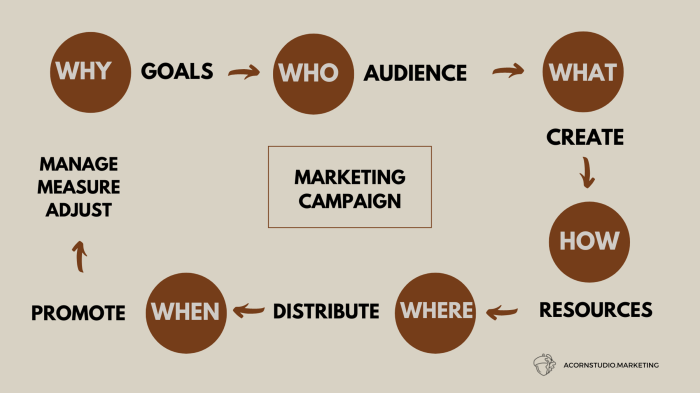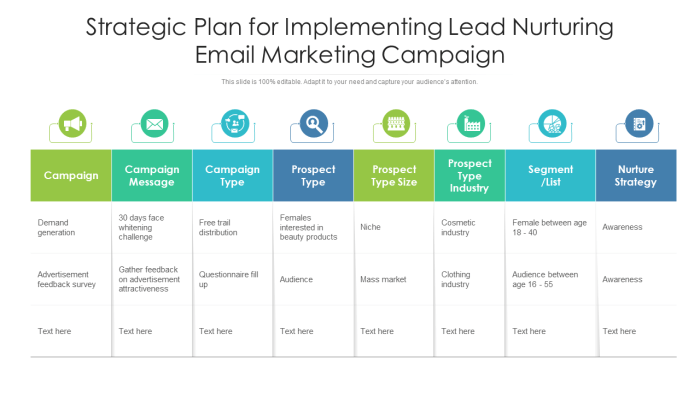Launching a successful marketing campaign requires strategic planning and efficient execution. This guide provides a structured five-week framework to help you design and implement a high-impact campaign, focusing on defining clear goals, creating engaging content, and meticulously tracking results. We’ll cover key aspects from identifying your target audience and crafting compelling buyer personas to developing a multi-channel strategy and measuring your campaign’s success using key performance indicators (KPIs).
From initial concept to final analysis, we’ll walk you through each stage, offering practical advice and actionable steps to maximize your return on investment. Learn how to leverage various marketing channels effectively, adapt your strategy based on real-time data, and ultimately achieve your marketing objectives within a concise timeframe.
Defining Goals and Target Audience

A successful marketing campaign hinges on clearly defined goals and a deep understanding of your target audience. Without these foundational elements, your efforts risk being scattered and ineffective, leading to wasted resources and missed opportunities. This section will guide you through the process of defining SMART goals and creating detailed buyer personas to ensure your 5-week campaign is laser-focused.
SMART Goals for a 5-Week Marketing Campaign
Developing SMART goals is crucial for tracking progress and measuring success. Each goal should be Specific, Measurable, Achievable, Relevant, and Time-bound. For example, instead of a vague goal like “increase brand awareness,” a SMART goal might be: “Increase website traffic by 20% within 5 weeks through targeted social media advertising and optimization.” This allows for precise measurement and demonstrates clear progress towards a defined objective. Consider setting several SMART goals covering different aspects of your campaign, such as lead generation, sales conversion, and brand engagement. Remember to align your goals with your overall business objectives.
Ideal Customer Profile
Creating a comprehensive ideal customer profile (ICP) is essential. This profile should paint a vivid picture of your ideal customer, encompassing demographics (age, location, income, education), psychographics (lifestyle, values, interests, attitudes), online behavior (social media usage, preferred websites, search habits), and pain points (problems your product or service solves). The more detailed your ICP, the more effectively you can tailor your messaging and channel selection. Consider using data analytics tools to gather insights into your existing customer base to inform your ICP.
Buyer Personas
To further refine your target audience, develop three distinct buyer personas representing different segments within your target market. These personas should be detailed, almost like character sketches, representing real individuals with specific needs and motivations. This allows for more nuanced messaging and targeted campaign strategies.
| Persona Name | Demographics | Psychographics | Buying Behavior |
|---|---|---|---|
| Sarah, the Busy Professional | 30-45 years old, high income, urban dweller, graduate degree | Values efficiency, convenience, and quality. Interested in self-improvement, professional development, and wellness. Active on LinkedIn and Instagram. | Researches extensively online before making a purchase. Prefers concise, informative content. Responsive to targeted advertising and email marketing. Highly values customer reviews and testimonials. |
| David, the Tech-Savvy Millennial | 25-35 years old, mid-range income, suburban dweller, college degree | Values innovation, technology, and social connection. Interested in gaming, gadgets, and new trends. Active on TikTok, YouTube, and Twitter. | Makes quick decisions based on online reviews and social proof. Engages with interactive content and influencer marketing. Susceptible to FOMO (fear of missing out). |
| Maria, the Budget-Conscious Parent | 35-50 years old, mid-range income, suburban dweller, high school diploma | Values family, practicality, and value for money. Interested in saving money, family activities, and educational resources. Active on Facebook and Pinterest. | Compares prices extensively. Responds to promotions and discounts. Values recommendations from friends and family. Prefers clear and simple messaging. |
Strategy and Content Creation

Developing a robust marketing strategy and compelling content is crucial for a successful campaign. This section Artikels the process of creating a content calendar, crafting engaging headlines and social media posts, and implementing a multi-channel marketing approach. Effective content resonates with your target audience, driving engagement and ultimately, conversions.
A well-defined content calendar ensures consistent messaging and efficient resource allocation. It allows you to plan and schedule content in advance, maximizing reach and impact. Furthermore, a coordinated approach across various channels strengthens brand awareness and reinforces key messages.
Content Calendar Development
A comprehensive content calendar should detail the type of content, target audience, platform, and publishing schedule. This provides a clear roadmap for content creation and distribution throughout the five-week campaign.
| Week | Content Type | Platform | Topic | Target Audience |
|---|---|---|---|---|
| 1 | Blog Post, Social Media Posts | Blog, Facebook, Instagram | Introduction to Product/Service, Key Benefits | All Target Personas |
| 2 | Email Newsletter, Social Media Posts, Short Video | Email, Twitter, YouTube | Customer Testimonials, Case Studies | High-value Persona A |
| 3 | Blog Post, Infographic, Social Media Posts | Blog, LinkedIn, Pinterest | Product/Service Features and Specifications | Persona B, interested in technical details |
| 4 | Email Newsletter, Social Media Contest, Paid Advertising | Email, Facebook, Google Ads | Limited-Time Offer, Promotion | All Target Personas |
| 5 | Blog Post, Social Media Roundup, Email Thank You | Blog, All Platforms, Email | Campaign Summary, Next Steps | All Target Personas |
Compelling Blog Post Headlines
Headlines are the first impression; they must grab attention and entice readers to learn more. These examples target different aspects of the product/service benefits.
- Headline 1: Unlock Your Potential: How [Product/Service] Can Transform Your [Industry/Area] (Focuses on transformation and potential)
- Headline 2: Stop Wasting Time and Money: [Product/Service] Delivers Results (Highlights efficiency and ROI)
- Headline 3: [Specific Problem] Solved: Introducing [Product/Service] – Your Solution (Addresses a pain point directly)
Social Media Post Designs
Tailoring social media posts to specific personas ensures greater relevance and engagement. Visuals and calls to action should be adjusted accordingly.
- Post 1 (Persona A – High-value customer): Platform: LinkedIn. Content: A short, professional video testimonial from a satisfied customer. Visual: High-quality image of the customer and their company logo. Call to Action: “Learn more about how [Product/Service] helped [Customer Company] achieve [Specific Result].”
- Post 2 (Persona B – Tech-focused customer): Platform: Twitter. Content: A concise infographic highlighting key features and specifications. Visual: A visually appealing infographic with clear data points. Call to Action: “Download the full spec sheet: [link]”
- Post 3 (Persona C – General audience): Platform: Instagram. Content: A visually engaging carousel post showcasing various uses of the product/service. Visual: High-quality images and short video clips. Call to Action: “Visit our website to learn more and claim your discount! [link]”
Multi-Channel Marketing Strategy
A multi-channel strategy leverages the strengths of different platforms to reach a wider audience. Resource allocation should reflect the potential ROI of each channel.
For example, a 50% budget allocation to paid advertising (Google Ads, Social Media Ads) could be effective in driving immediate results. 25% allocated to email marketing helps nurture leads and build relationships. The remaining 25% could focus on organic social media content to establish brand presence and engagement. This allocation is a suggestion and needs to be tailored to specific campaign goals and budget.
Implementation and Measurement

Successfully launching a marketing campaign requires a meticulous implementation plan and a robust measurement system to track progress and adapt strategies. This section Artikels the crucial steps involved in bringing your campaign to life and evaluating its effectiveness. We will cover developing a detailed implementation plan, defining key performance indicators (KPIs), establishing a data collection and analysis system, and outlining a plan for campaign adaptation based on collected data.
A well-defined implementation plan ensures all campaign elements align seamlessly, maximizing impact and minimizing wasted resources. Similarly, a robust measurement system provides crucial insights into campaign performance, allowing for timely adjustments and optimization.
Step-by-Step Implementation Plan
A detailed plan is essential for effective campaign execution. This plan should Artikel tasks, timelines, and responsibilities for each team member. It should also detail the distribution schedule for content across chosen channels.
- Week 1: Finalize all creative assets (graphics, videos, copy). Schedule social media posts and email blasts. Begin initial content seeding on chosen platforms.
- Week 2: Monitor initial campaign performance. Adjust social media posts based on engagement. A/B test email subject lines and content. Begin influencer outreach if applicable.
- Week 3: Analyze data collected in the first two weeks. Make necessary adjustments to campaign strategy based on performance. Increase spending on high-performing channels. Refine messaging based on audience feedback.
- Week 4: Maintain momentum. Continue to monitor performance and make minor adjustments as needed. Explore additional opportunities for content promotion and outreach.
- Week 5: Final campaign report. Analyze overall campaign performance against KPIs. Document learnings and recommendations for future campaigns.
Team responsibilities should be clearly defined in a project management tool, ensuring accountability and efficient workflow.
Key Performance Indicators (KPIs)
Tracking the right KPIs is critical for understanding campaign success. These metrics provide quantifiable data to assess progress and inform future strategies.
- Website Traffic: Measured using Google Analytics, this KPI tracks the number of visitors to the website and their behavior (bounce rate, time on site).
- Social Media Engagement: Tracked using native platform analytics (e.g., Facebook Insights, Twitter Analytics), this includes likes, shares, comments, and mentions.
- Lead Generation: Measured by the number of qualified leads generated through the campaign (e.g., form submissions, email sign-ups). This can be tracked using CRM software.
- Conversion Rate: This represents the percentage of leads that convert into customers. It’s calculated by dividing the number of conversions by the number of leads.
- Return on Investment (ROI): This crucial KPI measures the profitability of the campaign by comparing the campaign’s cost to the revenue generated.
Data Collection and Analysis System
A systematic approach to data collection and analysis is essential for making informed decisions. This involves using appropriate tools and techniques to gather and interpret data effectively.
Tools like Google Analytics, social media analytics dashboards, CRM systems, and spreadsheet software (like Google Sheets or Excel) can be utilized. Techniques such as data visualization (using charts and graphs) and statistical analysis can help identify trends and patterns.
Campaign Adaptation Plan
Regularly analyzing data allows for strategic adjustments to maximize campaign effectiveness. This section details how the campaign will be adapted based on different data outcomes.
Example 1: If website traffic from social media is low, we will investigate the quality of social media content, optimize targeting parameters, and experiment with different content formats (e.g., video vs. static images).
Example 2: If the conversion rate is significantly below target, we will review the landing page experience, optimize the call-to-action, and potentially A/B test different messaging to improve conversions.
Example 3: If a particular channel (e.g., Instagram) is significantly outperforming others, we will allocate more budget and resources to that channel to further capitalize on its success. Conversely, underperforming channels may see budget reallocation.
Closing Notes

Designing an effective marketing campaign in just five weeks demands a focused approach and precise execution. By carefully defining your goals, understanding your target audience, creating compelling content, and diligently tracking your KPIs, you can significantly increase your chances of success. Remember, adaptability is key; be prepared to adjust your strategy based on the data you collect. With diligent planning and consistent monitoring, you can achieve remarkable results within this ambitious timeframe, leaving a lasting impact on your brand and driving significant growth.